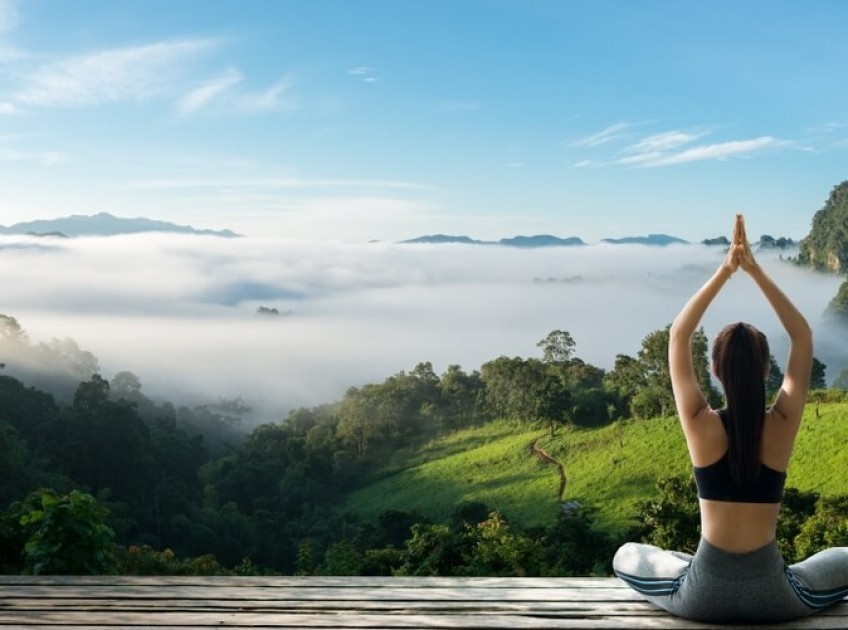
Parvatasana or the mountain pose holds its place among the steps of sun salutation which is also known as Surya Namaskar. As its name speaks of the origin of the name, Parvat stands for mountain and Asana represents the pose or posture in Sanskrit. This is the pose in yoga that resembles the mountain, therefore, it is named as the mountain pose
Parvatasana simply connects you to Mother Nature while rewarding the Shadhak with a long list of health benefits. Being the base of Surya Namaskar sequence, This pose inculcates stability, strength, and flexibility in the practitioner.
Below are the steps of Parvatasana.
Spread your palms below your shoulders, pointing your toes back.
Scroll your toes, press your palms down, and lift your knees up.
Your chin should be to the chest.
Your focus should be towards your palms, shoulder, and spine majorly.
Ground your palms and feet comfortably.
Breathe in and out, relax.
Hold the pose for a minute.
Release the pose gently.
_1702103215.jpg)
The benefits of Parvatasana are described below
This pose takes the body into an inversion, ensuring blood flow throughout. Imagine the energy flowing from your grounded feet hip-width apart, right up to the crown of your head in this foundational of standing pose. This asana of yoga smoothens the flow of blood right from the tip to the toe. This pose engages the whole body to reach the final pose, thereby infusing rich blood to all the organs, ensuring a healthy body.
This pose is best for the working folk who need a good and quick stretch in their time-bound schedule. The practice of the mountain pose brings the tight and firm spine in a natural ‘S’ shape, encouraging a lifted feeling from the base of your spine to the crown of your head. This pose benefits the muscles and spinal cord by making them flexible and giving them strength to take on the whole day easily. Therefore, this pose rewards the practitioner with a perfect body posture, cultivated through consistent body awareness in this standing posture.
This pose aids you in restoring the perfect balance between Pran and Apan. This yoga asana sets perfect coordination and balance between the upper and lower body, taking the human frame to a perfect equilibrium naturally, a balance you become more attuned to with increased body awareness.
This pose encourages the human body to attain more flexibility by loosening firm muscles and tensions while also strengthening the arms, shoulder blades, and hamstrings. The benefits of This pose can be seen in the lower back of the body as by the time and practice the practitioner achieves an immense level of strength and flexibility that not only prepares the practitioner for higher possibilities but also shields the body with various ailments and injuries, all while maintaining a strong and aligned standing posture.
This pose proves to be one of the best yoga asanas, benefiting the human race by boosting the organs of the body. This pose engages all the organs, ensuring a rich flow of blood to them to curb the lack of oxygen in the body and confirm their proper functioning, from the soles of your feet hip-width apart (or with big toes touching) to the very top.
This pose involves the movement of the belly, giving a natural massage to it that not only stimulates the secretion of necessary digestive juices but also provides you with a good digestive system. This pose coordinates all the organs of the digestive system with their proper functioning, a process enhanced by mindful body awareness.
The rich blood is directed to the mind while practicing this pose, flowing freely from your grounded feet upwards towards the crown of your head. Besides rendering remedies to physical ailments, this pose is a boon to mental hygiene. It relieves the mind of any sort of stress, anxiety, or mild depression, fostering a sense of calm that radiates through your entire standing posture, with your palms facing forward in a gesture of release.
In addition to this, this asana sets oneself free from any materialistic discomfort and unnecessary attachments, leading to the path of calmness and spirituality.
Also Read: What is Virabhadrasana Yoga (Warrior Pose), How to do and it's benefits?
If you are a beginner then it is possible to have less flexibility and due to a firm hamstring, your heels might not touch the ground. In such case simply bent your knees a little.
Bend your shoulder a bit down and try to correct your spine. You will find that when you do this automatically your spine will go up correctly and will help you in achieving the required flexibility by regular practice.
Before practicing the pose, strengthen your wrist to stay in the posture for long.
• Shoulder injury
• Blood pressure issues
• Spine injury
• Insomnia
• Headache
Get Parvatasana in your daily schedule to experience the health benefits of yoga asanas. Synchronize your body, soul, and mind by adding the benefits of yoga to your lifestyle to cherish the ultimate bliss of health and hygiene.
Read More: 11 Amazing Benefits of Chakrasana (The Wheel Pose)
If you're new to yoga and want to start practicing yoga in an organized way to learn the correct techniques for yoga asanas, our Yoga for Beginners course is the ideal choice for you. Explore our 100-hour Yoga Teacher Training course, offered by one of The Best Yoga School in Rishikesh, perfect for those interested in increasing their practice and teaching abilities.
Explore the world of healing and meditation through our exceptional Sound Healing Teacher Training course in Rishikesh. Designed for people who are passionate about learning and engaging with these activities that change lives